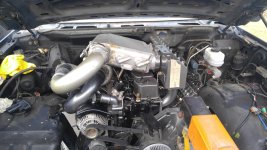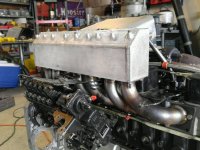alienturtle
Human
- Joined
- Jan 9, 2012
- Messages
- 97
Iv been running my 12v for quite a few years with below specs. I use my truck to tow a 40 foot gooseneck race trailer and daily drive. I have the cab and suspension off the truck doing a 4 link setup with king coilovers. (this is in a f350). I really dont have too many complaints with the setup. Just looking to improve if possible while its apart. I have a hx35 secondary and ht3b primary. The ht3b has a 26cm exhause housing. Im running a tial external wastegate. My question is. Would doing a hx35 40 hybrid be an improvement? I really dont want to have to change any hot side piping so i thought the hybrid might be a good option? If so where would you buy the wheel and compressor housing. Im a machinist so i can machine what ever is needed. Thanks.
Hx35 over ht3b compounds with external wastegate
Pretty stock p pump at 15 degree timing
Cpp 7x10 maybe 12 injectors
Hamilton towing cam
O ring head
Arp head studs
The intake has been milled off the head and a custom intake with water to air intercooler built
Nv5600 trans
Southbend street duel disk
Airdog fuel pump
Hx35 over ht3b compounds with external wastegate
Pretty stock p pump at 15 degree timing
Cpp 7x10 maybe 12 injectors
Hamilton towing cam
O ring head
Arp head studs
The intake has been milled off the head and a custom intake with water to air intercooler built
Nv5600 trans
Southbend street duel disk
Airdog fuel pump




